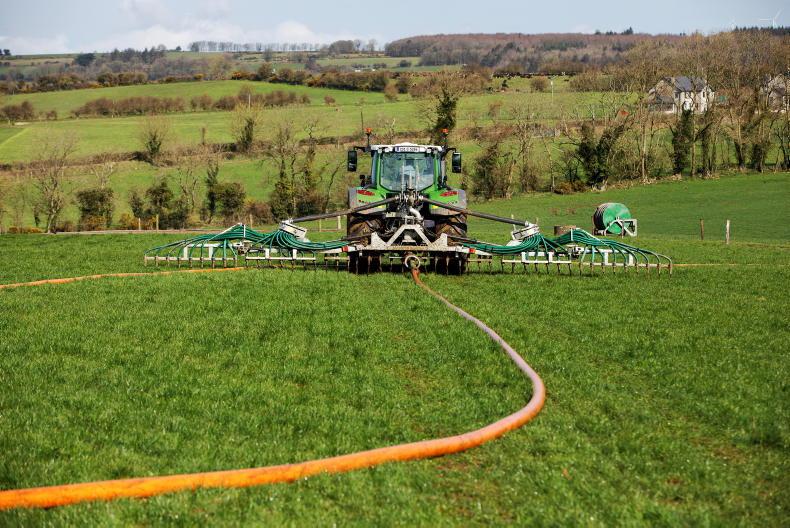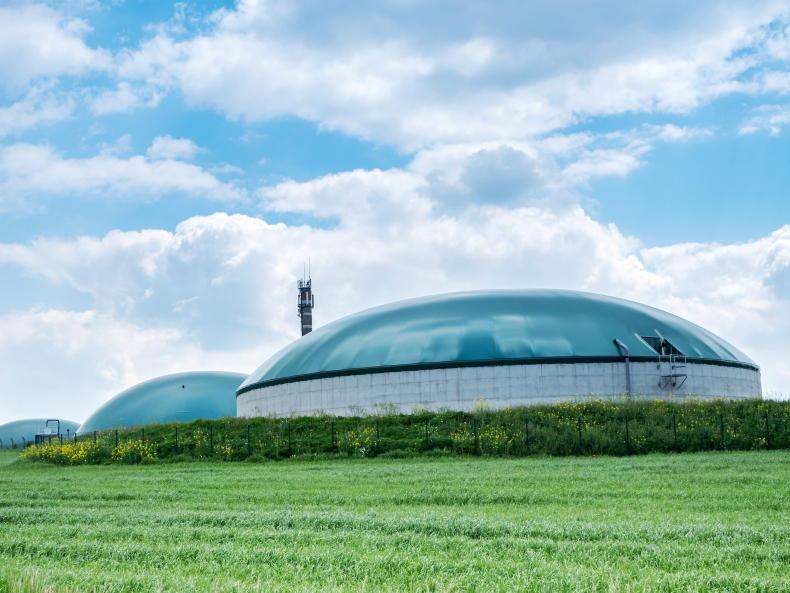It is no secret that meaningful policy support for anaerobic digestion (AD) in Ireland has lagged behind our European counterparts.
While I have highlighted this multiple times in the past, it is encouraging to see that this position is slowly changing.
A phrase borrowed from the UK-based ADBA group that resonates with me is “there is no net-zero without biogas”.
This realisation has also dawned on Irish policymakers and we’re seeing this manifest itself in the impending Renewable Heat Obligation scheme.
Developing an agriculture-based AD industry in Ireland could not only generate much-needed renewable energy for the heat and transport sectors, it could also provide additional income streams and markets for farmers, generate a homogenised organic biofertiliser, reduce agricultural and energy-related emissions and comply with 12 Irish and EU policy objectives.

There is no net-zero without biogas.
However, not everyone is convinced of this and one of the main issues which they are concerned about is the potential impact on the environment of developing a large-scale AD industry.
A new report, commissioned by Gas Networks Ireland and produced by KPMG and the Dowth Farm & Research Facility aims to address these concerns. This article summaries some of its key themes.
The scenario
The report outlines a scenario of developing 2.5 terawatt-hours of biomethane (upgraded biogas) per annum by 2030.
Replacing natural gas with this biomethane would result in carbon dioxide savings of over 500,000t.
In order to produce this volume of biomethane, 50,000ha of agricultural land would be required to produce 2.6 million tonnes (mt) (0.6mt DM) of plant-based feedstock for 125 AD plants.
This is 1.1% of Ireland’s agricultural land base and is the equivalent to 5% of the current volume of grass silage produced annually. The network of AD plants would also require 1.75mt of slurry, equivalent to 4% of the slurry currently captured in Ireland.
Feedstock
The report outlines that Ireland could produce an additional 3.1mt DM of feedstock from improved efficiency across the land already in agricultural production, far exceeding the 0.6mt DM required for AD plants. It states that this would not impact the feedstock currently used for livestock or need to utilise biodiverse or high-nature-value farmland.
CSO data shows that there is approximately 4.5m ha of available grassland in Ireland, of which they have calculated that 768,000ha is available and suitable to grow incremental feedstock for an AD industry. This land bank is primarily used for beef cattle grazing or beef sector silage production which has below optimal land fertility or crop yield.
Based on Teagasc figures, they say there is a lag in grass production on beef farms compared to dairy farms. This gap is identified as a key opportunity for incremental forage production for AD plants. Teagasc estimates that the top 25% of dairy farmers can produce at least 14t DM/ha and runs Grass10 to encourage all farmers to increase their production to 10t DM/ha. It is this benchmark yield of 10t DM/ha that the report has marked as being technically achievable on the vast majority of beef farms in Ireland compared to the current 6t DM/ha.
To achieve this, they say that correcting soil nutrition deficiencies and the use of multispecies swards on the farm is required. Teagasc national soil fertility trends show that 21% and 18% of dairy and drystock farms respectively have optimum fertility, ie optimum pH, phosphorus and potassium levels. Therefore, the scope to increase soil fertility and crop yields is immense.
In the short term (approximately five years), the report suggests more fertiliser and lime inputs will be needed to build soil fertility. However, once the initial fertility deficit is addressed, they suggest it is possible to produce the feedstock with significantly lower inputs, much of which will be met through the use of digestate.
The report largely focuses on grass and MSS but does outline that the 270,000ha of tillage land in Ireland could provide forage for AD plants through the use of temporary leys and growing energy-rich crops such as maize or sugar beet.
Multispecies swards
The report also examined the role of multispecies swards (MSS) in trials in Dowth. MSS are being trialled as a feedstock for AD plants given their potentially high yields with lower fertiliser requirements.

A field with a crop of multispecies swards at Dowth.
In 2020 trials, MSS mixes out yielded the control perennial ryegrass sward by approximately 2t DM/ha. This was achieved with a reduction of 100kg N/ha of artificial fertiliser application largely due to the legumes (nitrogen-fixing plants) in the sward. Crucially MSS also have significant benefits for above and below ground biodiversity.
Nutrients
In order for biomethane to comply with the Renewable Energy Directive II sustainability criteria, it must achieve at least a 70% GHG emission saving compared to natural gas, increasing to 80% for plants which start operating from 2026. Simply put, if biomethane doesn’t meet this criteria, it isn’t renewable.
In order to achieve this, plants it will require between a 40-55% inclusion of livestock slurry or manure. Ireland currently produces 100mt of slurry per annum, of which 40mt is captured in storage. AD offers the opportunity to capture the methane from that slurry but also allows those nutrients to be better used on farms in the form of digestate.

Digestate can supply significant amount of organic nutrients to crops.
A key objective of developing an indigenous AD industry would be to assist in Ireland’s decarbonisation and increase the environmental sustainability within the agricultural sector. Therefore, it is vital that activities associated with producing AD plant feedstocks don’t themselves lead to an increase in farm intensification such as increased use of chemical fertiliser.
Once soil nutrition is optimised, digestate will be used as the primary nutrition source first and foremost in all cases when producing AD feedstock.
For example, digestate could reduce nitrous oxide emissions by 37% (more if multispecies swards are used), when used as an organic fertiliser to avoid emissions associated with chemical fertiliser when growing grass silage and replace untreated slurry to displace significant GHG emissions.
The report states that replacing all nitrogen use with digestate on an average-sized beef farm could reduce on-farm emissions by 25%, or 3.9t of carbon dioxide equivalent. If 10% of farmers committed to this, there would be an estimated combined saving of 30,380t of carbon dioxide equivalent per annum.
Replacing all nitrogen use with digestate and growing multispecies swards on an average-sized dairy farms could reduce on-farm emissions by 66%, or 9.3t of carbon dioxide equivalent per farm. If 10% of farmers committed to this, there would be an estimated combined saving of 14,897t of carbon dioxide equivalent per annum.

It is no secret that meaningful policy support for anaerobic digestion (AD) in Ireland has lagged behind our European counterparts.
While I have highlighted this multiple times in the past, it is encouraging to see that this position is slowly changing.
A phrase borrowed from the UK-based ADBA group that resonates with me is “there is no net-zero without biogas”.
This realisation has also dawned on Irish policymakers and we’re seeing this manifest itself in the impending Renewable Heat Obligation scheme.
Developing an agriculture-based AD industry in Ireland could not only generate much-needed renewable energy for the heat and transport sectors, it could also provide additional income streams and markets for farmers, generate a homogenised organic biofertiliser, reduce agricultural and energy-related emissions and comply with 12 Irish and EU policy objectives.

There is no net-zero without biogas.
However, not everyone is convinced of this and one of the main issues which they are concerned about is the potential impact on the environment of developing a large-scale AD industry.
A new report, commissioned by Gas Networks Ireland and produced by KPMG and the Dowth Farm & Research Facility aims to address these concerns. This article summaries some of its key themes.
The scenario
The report outlines a scenario of developing 2.5 terawatt-hours of biomethane (upgraded biogas) per annum by 2030.
Replacing natural gas with this biomethane would result in carbon dioxide savings of over 500,000t.
In order to produce this volume of biomethane, 50,000ha of agricultural land would be required to produce 2.6 million tonnes (mt) (0.6mt DM) of plant-based feedstock for 125 AD plants.
This is 1.1% of Ireland’s agricultural land base and is the equivalent to 5% of the current volume of grass silage produced annually. The network of AD plants would also require 1.75mt of slurry, equivalent to 4% of the slurry currently captured in Ireland.
Feedstock
The report outlines that Ireland could produce an additional 3.1mt DM of feedstock from improved efficiency across the land already in agricultural production, far exceeding the 0.6mt DM required for AD plants. It states that this would not impact the feedstock currently used for livestock or need to utilise biodiverse or high-nature-value farmland.
CSO data shows that there is approximately 4.5m ha of available grassland in Ireland, of which they have calculated that 768,000ha is available and suitable to grow incremental feedstock for an AD industry. This land bank is primarily used for beef cattle grazing or beef sector silage production which has below optimal land fertility or crop yield.
Based on Teagasc figures, they say there is a lag in grass production on beef farms compared to dairy farms. This gap is identified as a key opportunity for incremental forage production for AD plants. Teagasc estimates that the top 25% of dairy farmers can produce at least 14t DM/ha and runs Grass10 to encourage all farmers to increase their production to 10t DM/ha. It is this benchmark yield of 10t DM/ha that the report has marked as being technically achievable on the vast majority of beef farms in Ireland compared to the current 6t DM/ha.
To achieve this, they say that correcting soil nutrition deficiencies and the use of multispecies swards on the farm is required. Teagasc national soil fertility trends show that 21% and 18% of dairy and drystock farms respectively have optimum fertility, ie optimum pH, phosphorus and potassium levels. Therefore, the scope to increase soil fertility and crop yields is immense.
In the short term (approximately five years), the report suggests more fertiliser and lime inputs will be needed to build soil fertility. However, once the initial fertility deficit is addressed, they suggest it is possible to produce the feedstock with significantly lower inputs, much of which will be met through the use of digestate.
The report largely focuses on grass and MSS but does outline that the 270,000ha of tillage land in Ireland could provide forage for AD plants through the use of temporary leys and growing energy-rich crops such as maize or sugar beet.
Multispecies swards
The report also examined the role of multispecies swards (MSS) in trials in Dowth. MSS are being trialled as a feedstock for AD plants given their potentially high yields with lower fertiliser requirements.

A field with a crop of multispecies swards at Dowth.
In 2020 trials, MSS mixes out yielded the control perennial ryegrass sward by approximately 2t DM/ha. This was achieved with a reduction of 100kg N/ha of artificial fertiliser application largely due to the legumes (nitrogen-fixing plants) in the sward. Crucially MSS also have significant benefits for above and below ground biodiversity.
Nutrients
In order for biomethane to comply with the Renewable Energy Directive II sustainability criteria, it must achieve at least a 70% GHG emission saving compared to natural gas, increasing to 80% for plants which start operating from 2026. Simply put, if biomethane doesn’t meet this criteria, it isn’t renewable.
In order to achieve this, plants it will require between a 40-55% inclusion of livestock slurry or manure. Ireland currently produces 100mt of slurry per annum, of which 40mt is captured in storage. AD offers the opportunity to capture the methane from that slurry but also allows those nutrients to be better used on farms in the form of digestate.

Digestate can supply significant amount of organic nutrients to crops.
A key objective of developing an indigenous AD industry would be to assist in Ireland’s decarbonisation and increase the environmental sustainability within the agricultural sector. Therefore, it is vital that activities associated with producing AD plant feedstocks don’t themselves lead to an increase in farm intensification such as increased use of chemical fertiliser.
Once soil nutrition is optimised, digestate will be used as the primary nutrition source first and foremost in all cases when producing AD feedstock.
For example, digestate could reduce nitrous oxide emissions by 37% (more if multispecies swards are used), when used as an organic fertiliser to avoid emissions associated with chemical fertiliser when growing grass silage and replace untreated slurry to displace significant GHG emissions.
The report states that replacing all nitrogen use with digestate on an average-sized beef farm could reduce on-farm emissions by 25%, or 3.9t of carbon dioxide equivalent. If 10% of farmers committed to this, there would be an estimated combined saving of 30,380t of carbon dioxide equivalent per annum.
Replacing all nitrogen use with digestate and growing multispecies swards on an average-sized dairy farms could reduce on-farm emissions by 66%, or 9.3t of carbon dioxide equivalent per farm. If 10% of farmers committed to this, there would be an estimated combined saving of 14,897t of carbon dioxide equivalent per annum.














SHARING OPTIONS